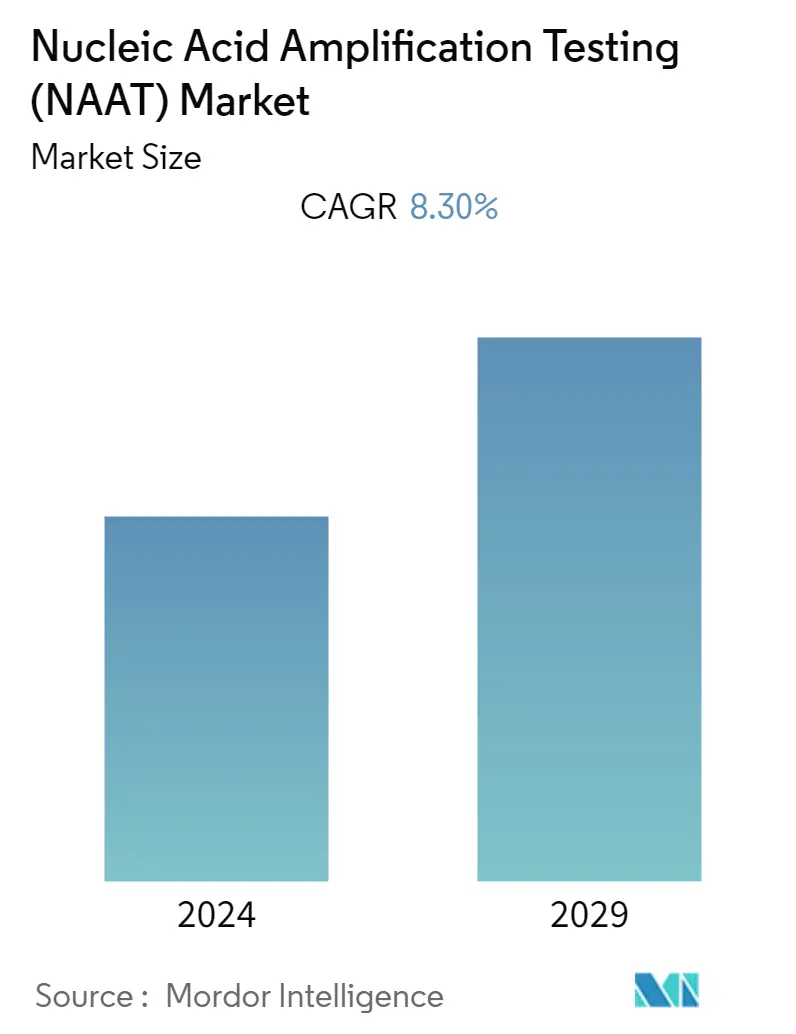Market Size of Nucleic Acid Amplification Testing (NAAT) Industry

| Study Period | 2019 - 2029 |
| Base Year For Estimation | 2023 |
| CAGR | 8.30 % |
| Fastest Growing Market | Asia-Pacific |
| Largest Market | North America |
| Market Concentration | Low |
Major Players*Disclaimer: Major Players sorted in no particular order |
Need a report that reflects how COVID-19 has impacted this market and its growth?
Nucleic Acid Amplification Testing Market Analysis
The nucleic acid amplification testing (NAAT) market is poised to grow at a CAGR of 8.3% over the forecast period.
The COVID-19 outbreak has significantly impacted the NAAT market as it was mainly recommended for the detection of a potent SARS-CoV-2 infection was a nucleic acid amplification (NAAT) test that detects one or more specific RNA-specific strains of the virus. According to the study published in Clinical Microbiological Infection in March 2021, in the COVID-19 diagnostic, the overall NAAT sensitivity was 89.1% and the specificity was 98.9%. As a result of the exceptional sensitivity and specificity of NAAT testing in the diagnosis of COVID-19, the demand for such tests spiked amid the pandemic. Therefore, the market during the pandemic might have been significantly impacted due to rise in sales of the NAAT test. Furthermore, the market is expected to show significant growth post-pandemic owing to the emergence of multiple strains of the COVID-19 viruses and other infectious diseases.
The major factors for the growth of the nucleic acid amplification testing (NAAT) market include the rising prevalence of infectious diseases, increasing demand for advanced diagnostic measures, and rising investment in the development of new biotechnological diagnostic techniques.
There is a high prevalence of infectious diseases such as tuberculosis and HIV, which are further responsible for the increasing demand for diagnostic tests, thereby positively impacting the growth of the studied market. For instance, as per the WHO in October 2022, an estimated 10.6 million people fell ill with tuberculosis(TB) worldwide in 2021. Among them 6 million are men, 3.4 million are women and 1.2 million are children. Thus, such a huge prevalence of infectious diseases such as tuberculosis is expected to propel the market's growth due to the rise in NAAT testing adoption.
Rising investments, adoption of key strategies, and product launches are further expected to drive the market in the future. For instance, in December 2021, Roche launched infectious disease tests on the Cobas 5800 System, a new molecular laboratory instrument, in countries accepting the CE mark. These include cobas HIV-1, cobas HBV, cobas HCV, cobas HIV-1/HIV-2 Qualitative, and the cobas omni-Utility Channel kit. Cobas HIV-1/HIV-2 Qualitative is an in vitro nucleic acid amplification test for the qualitative detection and differentiation of HIV-1 and HIV-2 in human serum, plasma, and dried blood spots. Such launch of innovative products for NAAT testing is expected to drive market growth due to increased adoption.
Thus, all the aforementioned factors such as rising prevalence of infectious diseases, rising initiatives of key market players in the launch of diagnostics for NAAT, and rising investments in new biotechnological diagnostic tests are expected to boost the market's growth over the forecast period. However, a lack of skilled professionals and higher costs associated with these tests may restrain the market's growth.
